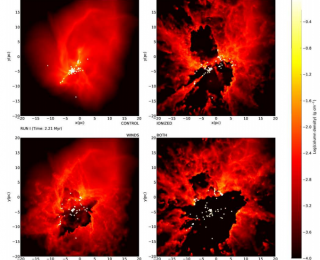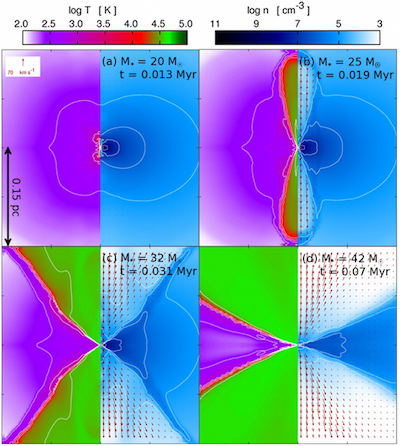
by Chris Faesi | Apr 29, 2014 | Daily Paper Summaries
Massive stars emit energetic radiation and expel strong winds that can disrupt their natal environments. New simulations show that these effects are important in the evolution of stellar nurseries and can account for some of the observed low efficiency of star formation.

by Anna Rosen | Dec 5, 2012 | Daily Paper Summaries
In this article, the authors study the effects of an optically thick disk around a forming massive protostar and examine how treating the gas opacity in the innermost dust-free region correctly affects the overall formation of massive stars.

by Nathan Goldbaum | Nov 13, 2011 | Daily Paper Summaries
Paper title: Protostellar Feedback Halts the Growth of the First Stars in the Universe Authors: Takashi Hosokawa, Kazuyuki Omukai, Naoki Yoshida, Harold W. Yorke Author’s Affiliation: Jet Propulsion Laboratory; Department of Physics, Kyoto UniversityThe problem of understanding the formation and evolution of the first to form stars in the universe lies at the intersection of many fields of astrophysics. Since the first stars could only have formed once their host dark matter halos had begun to collapse, one must understand the formation of these stars in a cosmological context, tracking gas from extremely low intergalactic densities (~10-27 g cm-3), to extremely high, stellar densities (~1 g cm-3). Since all the metal content of the universe had not yet been synthesized in the cores of stars, the gas that collapsed to form the first stars would have been metal-free and thus possessed very different thermal properties compared to the interstellar and intergalactic gas in the local universe that can cool via metal line emission.Many studies of first star formation have focused on the cosmological piece of the puzzle: starting with a simulation of cold dark matter and gas in a ΛCDM cosmology, they look for the first ~106 solar mass dark matter halo to collapse, and then follow the collapse of first the dark matter and then the gas to very high densities. Due to the extremely large dynamic range in these simulations, it becomes prohobitively expensive to reach stellar densities and impossible to directly model the evolution of the first star. For reference, a recent simulation of the formation of the first stars followed the collapse to densities just above 10-8 g cm-3, far below typical stellar...



